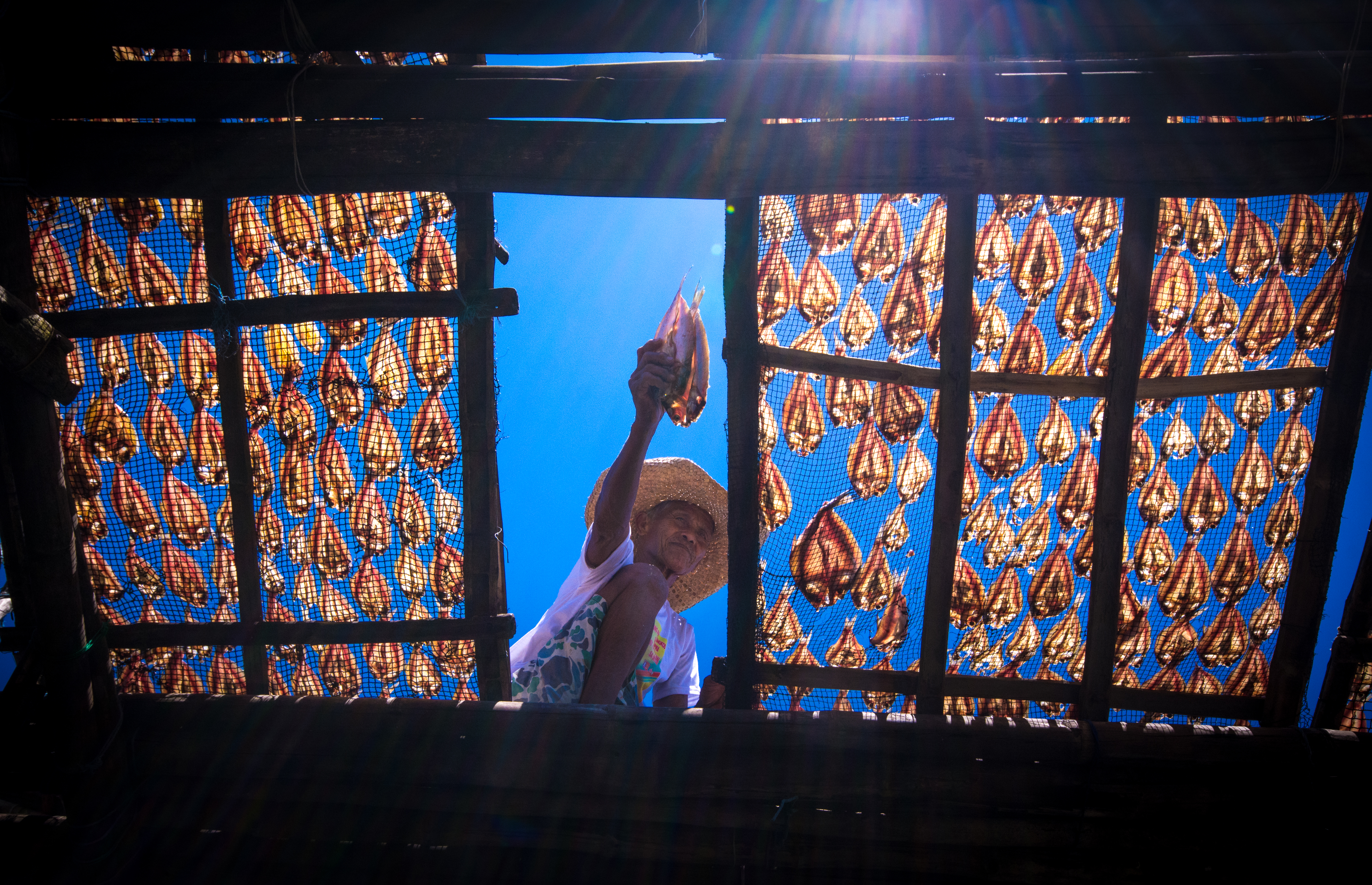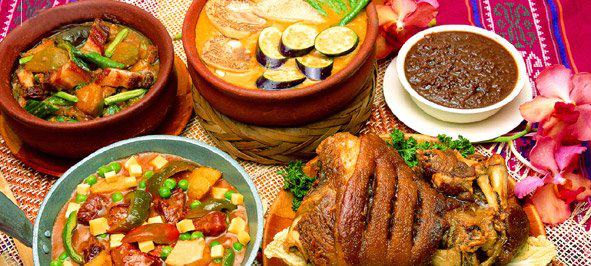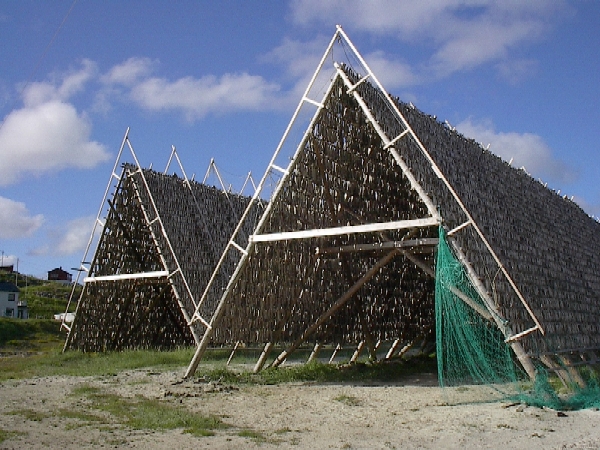|
Daing
''Daing'', ''tuyô'', ''buwad'', or ''bilad'' () are dried fish from the Philippines. Fish prepared as ''daing'' are usually split open (though they may be left whole), gutted, salted liberally, and then sun and air-dried. There are also "boneless" versions which fillet the fish before the drying process. It was originally a preservation technique, as salt inhibits the growth of bacteria, allowing fish to be stored for long periods of time. ''Daing'' is fried or grilled before consumption, though it can also be wrapped in foil and baked in an oven. It is usually dipped in vinegar and eaten with white rice for breakfast. Notably, it is traditionally paired with ''champorado'' (traditional Filipino chocolate rice gruel). It can also be used as an ingredient in other dishes. ''Daing'' is considered poverty food because it is relatively cheap but has gained significance in Philippine culture as comfort food. Preparation Virtually any fish can be prepared as ''daing''. The speci ... [...More Info...] [...Related Items...] OR: [Wikipedia] [Google] [Baidu] |
Filipino Cuisine
Filipino cuisine is composed of the cuisines of more than a hundred distinct Ethnic groups in the Philippines, ethnolinguistic groups found throughout the Philippines, Philippine archipelago. A majority of mainstream Filipino dishes that comprise Filipino cuisine are from the food traditions of various ethnolinguistic groups and tribes of the archipelago, including the Ilocano people, Ilocano, Pangasinan people, Pangasinan, Kapampangan people, Kapampangan, Tagalog people, Tagalog, Bicolano people, Bicolano, Visayan, Chavacano, and Maranao people, Maranao ethnolinguistic groups. The dishes associated with these groups evolved over the centuries from a largely indigenous (largely Austronesian peoples, Austronesian) base shared with maritime Southeast Asia with varied influences from Chinese cuisine, Chinese, Spanish cuisine, Spanish, and American cuisine, American cuisines, in line with the major waves of influence that had enriched the cultures of the archipelago, and adapted us ... [...More Info...] [...Related Items...] OR: [Wikipedia] [Google] [Baidu] |
Cuisine Of The Philippines
Filipino cuisine is composed of the cuisines of more than a hundred distinct ethnolinguistic groups found throughout the Philippine archipelago. A majority of mainstream Filipino dishes that comprise Filipino cuisine are from the food traditions of various ethnolinguistic groups and tribes of the archipelago, including the Ilocano, Pangasinan, Kapampangan, Tagalog, Bicolano, Visayan, Chavacano, and Maranao ethnolinguistic groups. The dishes associated with these groups evolved over the centuries from a largely indigenous (largely Austronesian) base shared with maritime Southeast Asia with varied influences from Chinese, Spanish, and American cuisines, in line with the major waves of influence that had enriched the cultures of the archipelago, and adapted using indigenous ingredients to meet local preferences. "Philippine Cuisine." ... [...More Info...] [...Related Items...] OR: [Wikipedia] [Google] [Baidu] |
Dried Fish
Fresh fish rapidly deteriorates unless some way can be found to preserve it. Drying (food), Drying is a method of food preservation that works by removing water from the food, which inhibits the growth of microorganisms. Open air drying using sun and wind has been practiced since ancient times to preserve food."Historical Origins of Food Preservation." Accessed June 2011. Water is usually removed by evaporation (air drying, sun drying, smoking or wind drying) but, in the case of freeze-drying, food is first frozen food, frozen and then the water is removed by sublimation (chemistry), sublimation. Bacteria, yeasts and molds need the water in the food to grow, and drying effectively prevents them from surviving in the food. Fish are Food preservation, preserved through such traditio ... [...More Info...] [...Related Items...] OR: [Wikipedia] [Google] [Baidu] |
Champorado
Champorado or tsampuradoVirgilio Almario, Almario, Virgilio, et al. 2010. ''UP Filipino Dictionary, UP Diksiyonaryong Filipino'', 2nd ed. Anvil Publishing, Anvil: Pasig. (from from ''champurrar'' 'to mix') is a sweet chocolate rice porridge in Cuisine of the Philippines, Philippine cuisine. Ingredients It is traditionally made by boiling Glutinous rice, sticky rice with ''tablea'' (traditional tablets of pure ground roasted cocoa beans). It can be served hot or cold, usually for breakfast or ''merienda'', with a drizzle of milk (or coconut milk) and sugar to taste. It is usually eaten as is, but a common pairing is with salted dried fish (''daing'' or ''Daing, tuyo''). ''Tinughong'' is a variant of champorado in the Bisayan languages, Visayan-speaking regions of the Philippines. It is usually made by boiling sticky rice with sugar instead of tablea. Coffee or milk are sometimes added to it. A popular new variant of champorado is ''ube champorado,'' which has a purple yam ('' ... [...More Info...] [...Related Items...] OR: [Wikipedia] [Google] [Baidu] |
Philippines
The Philippines, officially the Republic of the Philippines, is an Archipelagic state, archipelagic country in Southeast Asia. Located in the western Pacific Ocean, it consists of List of islands of the Philippines, 7,641 islands, with a total area of roughly 300,000 square kilometers, which are broadly categorized in Island groups of the Philippines, three main geographical divisions from north to south: Luzon, Visayas, and Mindanao. With a population of over 110 million, it is the world's List of countries and dependencies by population, twelfth-most-populous country. The Philippines is bounded by the South China Sea to the west, the Philippine Sea to the east, and the Celebes Sea to the south. It shares maritime borders with Taiwan to the north, Japan to the northeast, Palau to the east and southeast, Indonesia to the south, Malaysia to the southwest, Vietnam to the west, and China to the northwest. It has Ethnic groups in the Philippines, diverse ethnicities and Culture o ... [...More Info...] [...Related Items...] OR: [Wikipedia] [Google] [Baidu] |
Squid
A squid (: squid) is a mollusc with an elongated soft body, large eyes, eight cephalopod limb, arms, and two tentacles in the orders Myopsida, Oegopsida, and Bathyteuthida (though many other molluscs within the broader Neocoleoidea are also called ''squid'' despite not strictly fitting these criteria). Like all other cephalopods, squid have a distinct head, Symmetry (biology)#Bilateral symmetry, bilateral symmetry, and a mantle (mollusc), mantle. They are mainly soft-bodied, like octopuses, but have a small internal skeleton in the form of a rod-like gladius (cephalopod), gladius or pen, made of chitin. Squid diverged from other cephalopods during the Jurassic and occupy a similar Ecological niche, role to teleost fish as open-water predators of similar size and behaviour. They play an important role in the open-water food web. The two long tentacles are used to grab prey and the eight arms to hold and control it. The beak then cuts the food into suitable size chunks for swal ... [...More Info...] [...Related Items...] OR: [Wikipedia] [Google] [Baidu] |
Stockfish
Stockfish is unsalted fish, especially cod, dried by cold air and wind on wooden racks (which are called "hjell" in Norway) on the foreshore. The drying of food is the world's oldest known preservation method, and dried fish has a storage life of several years. The method is cheap and effective in suitable climates; the work can be done by the fisherman and family, and the resulting product is easily transported to market. Over the centuries, several variants of dried fish have evolved. The ''stockfish'' (fresh dried, not salted) category is often mistaken for the ''klippfisk'', or salted cod, category where the fish is salted before drying. Salting was not economically feasible until the 17th century, when cheap salt from southern Europe became available to the maritime nations of northern Europe. Stockfish is cured in a fermentation process where cold-adapted bacteria matures the fish, similar to the maturing process of cheese. In English legal records of the medieval ... [...More Info...] [...Related Items...] OR: [Wikipedia] [Google] [Baidu] |
Kipper
A kipper is a whole herring, a small, oily fish, that has been split in a butterfly fashion from tail to head along the dorsal ridge, gutted, salted or pickled, and cold-smoked over smouldering wood chips (typically oak). In the United Kingdom, Ireland and some regions of North America, kippers are most commonly eaten for breakfast. In the United Kingdom, kippers, along with other preserved smoked or salted fish such as the bloater and buckling, were also once commonly enjoyed as a high tea or supper treat, most popularly with inland and urban working-class populations before World War II. Terminology The word is thought to derive from the Old English ''cypera'', or copper, based on the colour of the fish. The word has various possible parallels, such as Icelandic ''kippa'' which means "to pull, snatch" and the Germanic word ''kippen'' which means "to tilt, to incline". Similarly, the Middle English ''kipe'' denotes a basket used to catch fish. Another theory traces the ... [...More Info...] [...Related Items...] OR: [Wikipedia] [Google] [Baidu] |
Clipfish
Dried and salted cod, sometimes referred to as salt cod or saltfish or salt dolly, is cod which has been preserved by drying after salting. Cod which has been dried without the addition of salt is stockfish. Salt cod was long a major export of the North Atlantic region, and has become an ingredient of many cuisines around the Atlantic and in the Mediterranean. Dried and salted cod has been produced for over 500 years in Newfoundland, Iceland, and the Faroe Islands. It is also produced in Norway, where it is called klippfisk, literally "cliff-fish". Traditionally, it was dried outdoors by the wind and sun, often on cliffs and other bare rock-faces. Today, ''klippfisk'' is usually dried indoors with the aid of electric heaters. History Salt cod formed a vital item of international commerce between the New World and the Old, and formed one leg of the so-called triangular trade. Thus, it spread around the Atlantic and became a traditional ingredient not only in Northern Europea ... [...More Info...] [...Related Items...] OR: [Wikipedia] [Google] [Baidu] |
Burong Isda
''Burong isda'' (literally "fermented fish") is a Philippine_cuisine, Filipino dish consisting of cooked rice and raw fish fillet, filleted fermented fish, fish fermentation (food), fermented with salt and ''angkak'' (red yeast rice) for around a week. The dish is common in central Luzon, most notably in the province of Pampanga. ''Angkak'' may also be omitted, especially in western central Luzon, resulting in a white-colored version. ''Burong isda'' variants are usually named after the fish they were made with; e.g. ''burong bangus'' for ''burong isda'' made with ''bangus'' (milkfish). Shrimp versions of the dish are known as ''burong hipon'' or ''balao-balao''. ''Burong isda'' is very similar to other fermented fish and rice dishes of Asia, including ''narezushi'' of Japanese cuisine and ''pla ra'' of Thai cuisine. All of these dishes rely on lactic acid fermentation to preserve the food. See also *Binagoongan *Daing *Kinilaw *Tapai *Burong mangga *Atchara External links * ... [...More Info...] [...Related Items...] OR: [Wikipedia] [Google] [Baidu] |
Tinapa
Tinapa ''Tinapa'', a Filipino term, is fish cooked or preserved through the process of smoking. It is a native delicacy in the Philippines and is often made from blackfin scad (''Alepes melanoptera'', known locally as ''galunggong''), or from milkfish, which is locally known as ''bangus''. Though canned ''tinapa'' in tomato sauce is common and sold commercially throughout the country, it is also still produced and sold traditionally or prepared at home. ''Tinapa'' recipe mainly involves the process of washing the fish and putting it in brine for an extended amount of time (usually 5 – 6 hours), air drying and finally smoking the fish. The fish species which are commonly used for making ''tinapa'' could either be ''galunggong'' (scads) or ''bangus'' (milkfish). The term ''tinapa'' means "prepared by smoking". The root word ''tapa'' in Philippine languages originally meant fish or meat preserved by smoking. In the Spanish Philippines, it came to refer to meats (modern ''ta ... [...More Info...] [...Related Items...] OR: [Wikipedia] [Google] [Baidu] |







